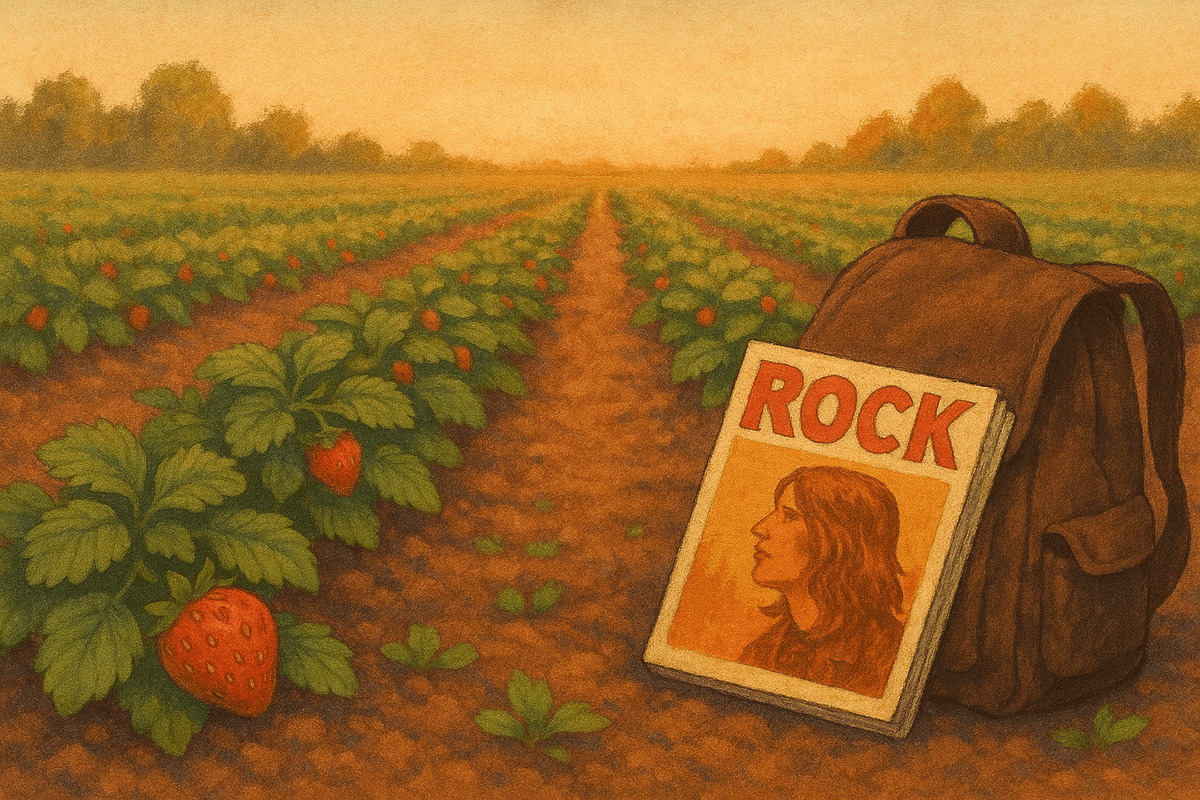From paper runs to pixel pushes — because why settle for one career crisis when you can have five.
You know, when I think about the job market today — with its remote work setups, AI-generated CVs, and LinkedIn endorsements — I can’t help but chuckle at how different things were when I first dipped my toes into the world of work.
My very first “job” was more of a weekend hustle. My sister and I had our own newspaper run — no contracts, no onboarding, just a sack of papers and a sense of responsibility.
Then came the strawberry picking. You’d get up at the crack of dawn on the weekend, already rostered on—just waiting to hear which patch you’d be assigned. The pay was piece work: every berry counted, every bucket tallied. You learned not to eat too many unless you fancied a trip to the long drop. It wasn’t glamorous, and the earnings were modest—maybe $15 if you were lucky—but it gave you a way to buy the little extras your parents couldn’t always stretch to. For me, that was usually a rock magazine. That small taste of independence made it feel worthwhile.

Then came the supermarket gig — packing groceries. You’d add your name to a list and hope for a shift. It’s funny how that role has all but vanished now, replaced by self-checkouts and scan-as-you-go apps. But back then, it was a foot in the door.
I eventually landed a receptionist job at a building supply firm. It was steady, structured, and gave me a taste of the “9 to 5” life. That led me to the city, where I took a receptionist role with a lawyer — for exactly one day. My OCD couldn’t handle the chaos. Papers everywhere, phones ringing off the hook, no system in sight. I knew I had to pivot.
An agency placed me at an insurance brokerage, and that’s where things started to shift. The company went through a whirlwind of changes, and I found myself evolving with it — from assistant broker to eventually moving to Australia and working with their sister company. In between, I temped at a bank just to keep the bills paid. One day, they called me up and offered me a full-time role. That call changed everything.
Then came the big leap — off to the UK to fund my OE (overseas experience). I started working in a bar, just enough to cover food and rent. Eventually, I moved into a full-time role, then into a bar with live musicians (a dream gig for someone who loves a bit of rhythm in their routine). Travel opened doors I didn’t know existed.
Back in NZ, I had my baby and worked part-time at an insurance broker. But the travel bug bit hard again. A colleague told me how to apply for temp roles at Air NZ, and I was in. Seven years flew by — from temporary clerk to database management and another child. Then came my first redundancy, thanks to the Ansett collapse. It was a shock, but also a turning point.

I set up my own business, working with IATA to move their bank settlement plan to a new platform. That project wrapped, and we moved back to the UK, helping my husband run a bar. Eventually, we returned to NZ, and I went back to study — earning my degree in Information Management while raising my kids.
That led to Vodafone, where I became the Systems Administrator for their financial systems across NZ, Australia, and Qatar. I worked on data cleansing and mapping for a SAP migration, which — you guessed it — ended in another redundancy.
From there, I joined a software house supporting resellers in ERP, HR, CRM, SCM, POS, and Payroll. The company was acquired by MYOB, and I became the support team leader and BA for their Salesforce implementation. But burnout whispered, and I listened.
I moved into a disability organisation as a Business Analyst, leading the digitisation of their onboarding process and designing an online workflow to support accessibility. It was meaningful work — the kind that stays with you.
🍓 Still Picking Strawberries — Just Digitally Now
Those early jobs taught me something that no certificate ever could: how to show up. Rain or shine, we had a run to do. No excuses, no algorithms deciding our worth. Just us, a paper route, and a strawberry patch.
Fast forward to now, and I’m still showing up — just in a different way.
I’ve been out of paid work for 12 months. Cyndiverse is my passion project, my portfolio, and my protest — but it’s not paying the bills. Financially, things are tight. Homelessness isn’t just a distant fear anymore; it’s a shadow that creeps closer with each passing month. But I know my skills are valuable. I know what I bring to the table — strategic thinking, emotional intelligence, systems design, and a knack for turning complexity into clarity.
So I’ve built a job strategy that’s more than just sending CVs into the void. I’m using Cyndiverse to showcase what I can do — blending storytelling, systemic critique, and tech exploration. I’m learning to “speak robot” through natural language processing, not just to keep up, but to contribute meaningfully to the future of work.
Every weekday, I post a short blog on LinkedIn — part journal, part signal flare. It’s my way of staying visible in a market flooded with overseas applicants and automated screening tools. I’m tired of fighting bots that don’t understand nuance, and tired of being filtered out because I don’t have the latest certificate — the kind that proves you can follow instructions, not necessarily innovate.
But I’m hopeful. I believe there’s an employer out there who values lived experience, strategic insight, and the kind of resilience you can’t teach in a course. Someone who sees beyond the checkbox and recognizes the depth behind the CV.
💼 Why LinkedIn Still Matters
I’ve been on LinkedIn for years, and I still love it. It’s not cluttered with “look at me” influencers — it’s a business community, a learning hub, and a place where real connections happen. Most of my followers are people I’ve actually worked with or connected with through shared interests. That matters.
It’s also a great platform for learning — though choosing the right course is tricky. For me, it needs to align with a tech skill set that’s actually in demand. Not just another badge, but something that bridges the gap between what I know and what the market needs.
🌟 Choose the path that lets you shine
The job market may be shifting, shrinking, and sometimes downright overwhelming — but here’s what hasn’t changed: the power of showing up. From weekend paper runs to digitising disability support systems, every chapter has taught me something about grit, growth, and grace.
I’m not chasing certificates — I’m chasing connection. Because the right employer won’t just look for a checkbox; they’ll look for someone who’s lived, adapted, and led through change.
And here’s the truth I hold onto: I am the star of my own story. Not a side character. Not a footnote. A protagonist who’s still writing the next chapter — with courage, creativity, and a touch of cosmic flair.
There’s power in showing up — not perfectly polished, but present and real. You don’t need a certificate to prove your worth, or a title to validate your impact. The right opportunities won’t ask you to shrink; they’ll recognize the light you already carry. So if you’re standing at a crossroads, don’t just choose what’s safe. Choose what lets you shine.
Written by Cindy — creator of Cyndiverse, lover of luminous metaphors, and firm believer in second (and third) acts.
You’re the star of your own story.

